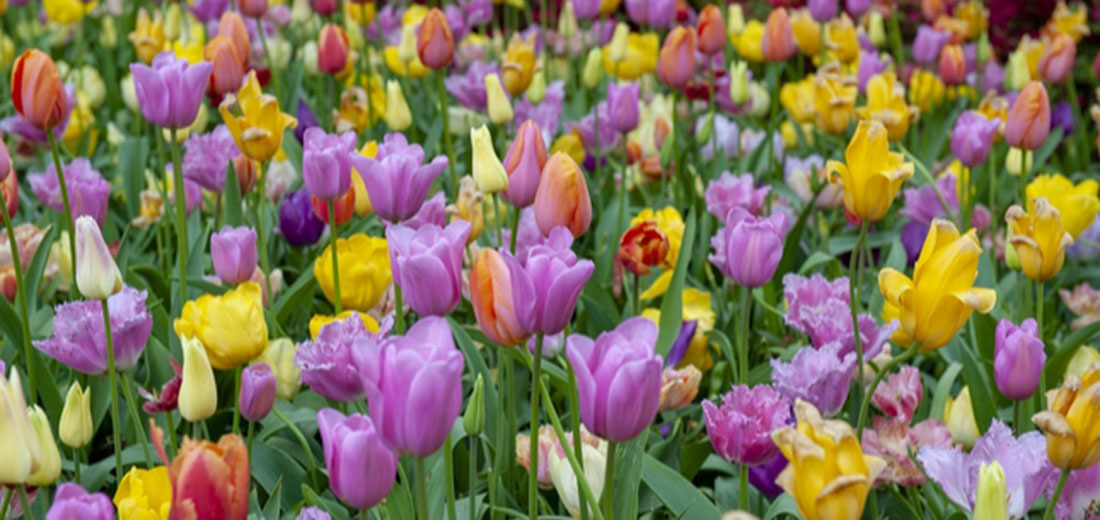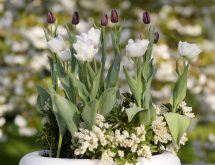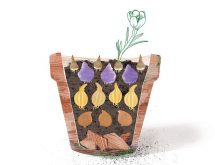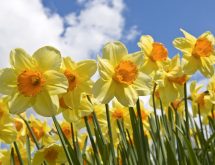
One of the easiest ways to have a gorgeous spring garden is to plant fall bulbs. They’re easy to plant, low-maintenance, and are some of the first plants to bloom in the spring, giving you a colorful garden as early as possible. Plus, fall is a wonderful time to enjoy working in the garden. The weather is cool and your garden to-do list isn’t as big as it is during spring planting season.
It may seem a bit odd, but spring-blooming bulbs must be planted in the fall. They need to go through a “chilling period” to bloom. You can plant bulbs throughout the fall, but make sure you get them in before the ground freezes.
How to Plant Efficiently
 The first step is to select a spot for your bulbs. Most bulbs do best when planted in well-drained soil where they’ll receive full sun during the summer. There are shade-tolerant varieties that are an exception.
The first step is to select a spot for your bulbs. Most bulbs do best when planted in well-drained soil where they’ll receive full sun during the summer. There are shade-tolerant varieties that are an exception.
It’s generally more efficient to dig trenches and larger holes for multiple bulbs, rather than small holes for individual bulbs. This also helps to loosen and prepare the soil, and you can take this opportunity to add organic fertilizer, such as Espoma Bulb Tone, a long-lasting, slow-release feeding with no fillers or sludges. Bulbs will do best in well-drained soil that’s rich in organic matter.
 Keep in mind that most bulbs should be planted in holes two to three times deeper than the height of the bulb. Specific planting depths for each variety should be listed on the packaging. Try layering bulbs to create a fuller garden. Plant larger bulbs at the bottom, add some soil, then plant smaller bulbs closer to the surface. You can also use layering to achieve a longer bloom period. Opt for varieties that bloom at different times throughout the spring to keep your garden looking full and colorful. Consider layering in containers using a method called “lasagna planting.” This creates a bulb container garden that will be full and beautiful in spring.
Keep in mind that most bulbs should be planted in holes two to three times deeper than the height of the bulb. Specific planting depths for each variety should be listed on the packaging. Try layering bulbs to create a fuller garden. Plant larger bulbs at the bottom, add some soil, then plant smaller bulbs closer to the surface. You can also use layering to achieve a longer bloom period. Opt for varieties that bloom at different times throughout the spring to keep your garden looking full and colorful. Consider layering in containers using a method called “lasagna planting.” This creates a bulb container garden that will be full and beautiful in spring.
Maintenance
Beyond proper planting, you can help your bulbs thrive with a little care. After planting, give them a thorough watering and keep their bed weed-free. Adequate watering encourages bulbs to send out roots. Use mulch to help prevent weeds and keep the soil moist.
Favorite Fall Bulbs
Some fall bulbs don’t perform well for very long and should be treated as annuals. Replant these bulbs each fall:
- Tulips
- Anemones
- Ranunculuses
Others last much longer and can be treated as perennials. These include:
- Alliums
- Crocuses
- Hyacinths
- Daffodils
- Snowdrops
How to Protect from Critters
 Small animals, such as squirrels, often like to dig up freshly-planted bulbs. Use a cheap piece of chicken wire to prevent this. Just lay the wire down over your planted bulbs and weigh it down so that critters can not get under it to dig. It should be safe to remove it in the spring when you see your bulbs starting to sprout. You can also try planting resistant varieties. Alliums, frittilaria, hyacinths and daffodils are our favorite choices.
Small animals, such as squirrels, often like to dig up freshly-planted bulbs. Use a cheap piece of chicken wire to prevent this. Just lay the wire down over your planted bulbs and weigh it down so that critters can not get under it to dig. It should be safe to remove it in the spring when you see your bulbs starting to sprout. You can also try planting resistant varieties. Alliums, frittilaria, hyacinths and daffodils are our favorite choices.
Spend some time out in the garden enjoying the autumn weather and adding some fall bulbs to your garden. Bulbs are an easy, affordable way to achieve a colorful, early spring garden. A little extra work now means you’ll have a beautiful spring!
